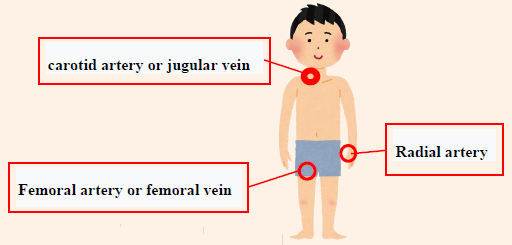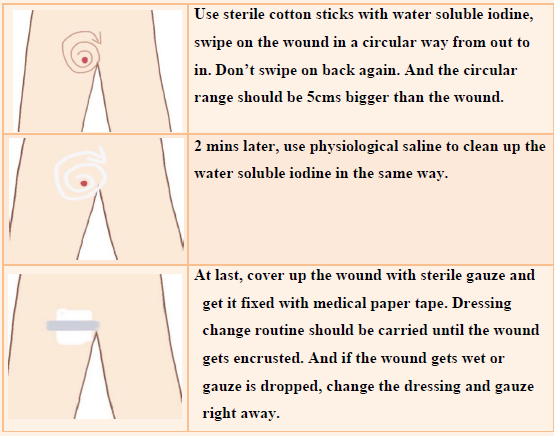【Learning points】
- Before cardiac catheterization, infants should fast for 4-6 hours, children and adults fast for 6-8 hours.
- Please take off your underwear (except diapers) when you are notified for cardiac catheterization.
- After pulling out the inspection catheter, the doctor will first press the wound with his hands to stop the bleeding, and then come back to the ward to continue to use a sand bag to stop the bleeding. The hemostasis time is according to the doctor's instructions; you must lie down for 4-6 hours without getting out of bed.
- Within 24 hours after the catheter is removed, do not exert too much force on the affected limb, do not lift heavy objects, and do not exercise vigorously.
- Patient may have to return to the hospital when the puncture wound has inflammation symptoms such as redness, swelling, heat, serious pain or bruise swelling over the catheterization site,and observe the urine color, like hematuria or tea colored urine.
I.What is cardiac catheterization?
The cardiac catheter is a soft and sterile catheter that can insert into a blood vessel in the groin, an artery in the forearm, or a blood vessel in the neck. With the aid of X-ray, it is placed along the blood vessels to the heart, then the contrast injection is used to evaluate the condition of the heart, valves and coronart artery as a technique for diagnosis and treatment, it can also as an examination or follow-up before and after heart surgery.
II.What does the situation need to implement the cardiac catheterization?
- The examination:
The cardiac catheterization can view the heart structure,heart function, blood flow,occlusion of cardiac vascular, oxygenation, cardiac electrical physiology, pressure value of cardiac, cardiac biopsy, etc. - The treatment:
Device closure of congenital heart defects, including patent ductus arteriosus(PDA), atrial septal defect(ASD), ventricular septal defect(VSD).Balloon dilation, placement of stent treat stenosis blood vessels. The electrocautery or placement of a pacemaker treat arrhythmias.
III.The precautions of cardiac catheterization:
- Before Examination
- Hospitalization is arranged and patient will need to have a routine blood analysis, chest X-ray, electrocardiogram, and echocardiography.

- Sedation Anesthesia Permit and Cardiac Catheterization Permit must be accomplished by the legal guardian of the children.
- Take a shower to keep skin clean.
- Before cardiac catheterization, infants should fast for 4-6 hours, children and adults fast for 6-8 hours.
- An intravenous line will be performed so that medications and fluids can be given through your vein during the procedure.
- Please tell the doctors or nurses if you or your children have any uncomfortable symptoms.

- Hospitalization is arranged and patient will need to have a routine blood analysis, chest X-ray, electrocardiogram, and echocardiography.
- During Examination
- Please take off your underwear (except diapers) when you are notified for cardiac catheterization.
- Cardiac catheterization usually takes about 90 ~120 minutes, including the preparation in nursing station to recovery time in cardiac catheterization room. Some patients needing special treatments will require more time during the procedure. Family members should wait outside the cardiac catheterization room patiently.
- Sedative drugs will be given to help patient relax ifnecessary.
- Sterilization and local anesthesia will be performed by the cardiologist at the catheter insertion site. Then, the catheters will be inserted at the right or left groin into the heart. When the catheter is in place, a small amount of contrast will be injected into the blood vessels or the heart and digital x-ray films will be used to show images of how the blood flows inside the heart.

- After Examination
- The notice of sheathe remove
- After pulling out the inspection catheter, the doctor will first press the wound with his hands to stop the bleeding, and then come back to the ward to continue to use a sand bag to stop the bleeding. The hemostasis time is according to the doctor's instructions; you must lie down for 4-6 hours without getting out of bed.
- On the day of cardiac catheterization, get out of bed should be reduced, pressurized with a sand bag for 4-6 hours (to avoid rebleeding), and the wound should be kept dry (to prevent bacterial infection).
- If you lie down and pressurize with the sand bag, please pay attention to whether there is blood oozing from the wound during activities. If there is blood oozing, please notify the nursing staff immediately. If the wound continues to ooze blood, the sand bag will continue to pressurize the wound. Until there is no bleeding.
- Within 24 hours after the catheter is removed, do not exert too much force on the affected limb, do not lift heavy objects, and do not exercise vigorously.
- If you need to use the toilet while lying flat, please notify the nurse to assist with the use of diapers, bedpans or urinals on the bed.
- Nursing staff will regularly monitor the breathing, heartbeat, blood pressure, and the presence of bleeding at the puncture site, and whether the lower extremities turn purple or black, swell, or have poor local blood circulation.
- Family members should help to observe patient's condition. If dizziness, chest tightness, palpitation, nausea/vomit, sweating, bleeding from the gauze on the wound, and confusion, conscious change or any uncomfortable symptoms occurred, do notify the doctor and nurse immediately.

- After backing from sedation,the patient could be feed with little water. If no vomiting or choking was found observation 30 minutes, the patient could eat without contraindications.
- Your child would need to be transferred to Pediatrics Intensive Care Unit(PICU) if special treatments were performed during the examination or the patient had a critical congenital heart disease with serious condition.
- The wound should be checked and dressing changed by the doctor next day. After the interpretation of Electrocardiogram, Echocardiopraphy Laboratory, or Chest X-ray, the doctor will determine the date of discharging from the hospital.
- The notice of sheathe remove
V. The precautions after you discharged:
- Gauze and dressing should be changed every day and the wound should stay dry and clean after you discharged. The ways to change them are as the following:

- If you had treatment, the medicine must be taken on time according to the doctor's instructions after cardiac catheterization.
- Patient may have to return to the hospital when the puncture wound has inflammation symptoms such as redness, swelling, heat, serious pain or bruise swelling over the catheterization site,and observe the urine color, like hematuria or tea colored urine.
- Exercise as what the doctor recommends, and also take
medication to prevent infective endocarditis.
VI.Reference:
- Hayes, N., & Ho, A. (2021). Current techniques and procedures in paediatric and congenital cardiac catheter intervention.ediatrics and Child Health, 31(2), 75-84.https://doi.org/10.1016/j.paed.2020.11.003.
- Yassin, H., & Al-Saloos, H. (2022). Diagnosis and therapeutic cardiac catheterization of symptomatic bicuspid aortic stenosis in the pediatric population. Heart Views, 23(1), 47. http://doi.org/10.4103/heartviews.heartviews_39_22
簡易測驗
Let's take a test to confirm that you have a thorough understanding.
評語
統計結果不開放
請登入後才可以評分
未登入或權限不足!
- 位置
-
- 資料夾名稱
- English
- 上傳者
- 尤怡婷
- 單位
- 中榮護理衛教
- 英文名稱
- Pediatric Cardiac Catheterization Care
- 分類
- 檢查
- 科別
- 英語
- 癌症照護
- 否
- 建立
- 2023-12-30 14:09:52
- 制訂日期
- 2012-02-28
- 最近修訂
- 2024-03-11 21:41:00